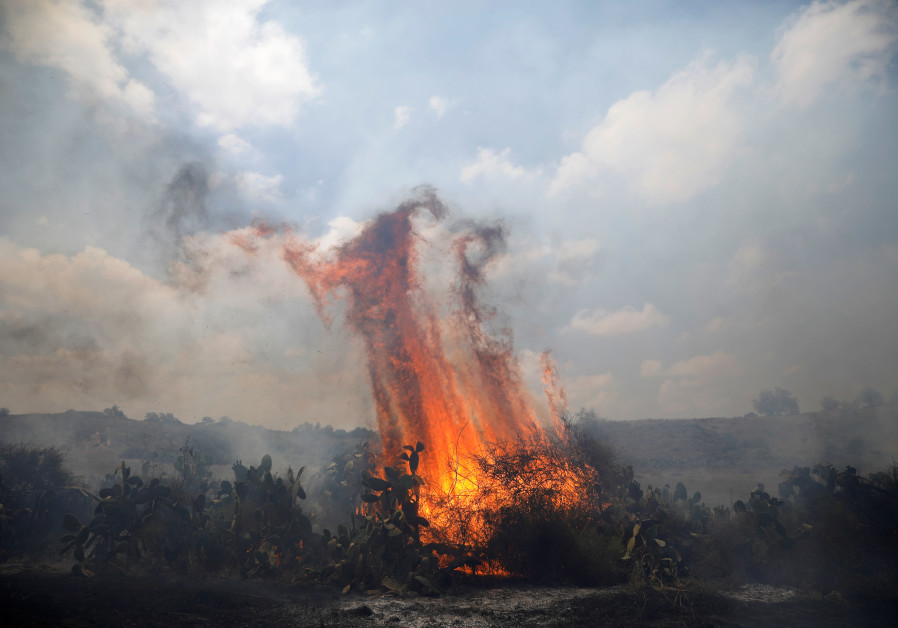ANALYSIS: Another futile round?

A fire burns in scrubland on the Israeli side of the border between Israel and the Gaza Strip, near kibbutz Gevaram. (photo credit: AMIR COHEN/REUTERS)
Four years after Operation Protective Edge, Israeli citizens are once again wondering if this summer will bring yet another war.
Another summer, another war. That’s usually how it goes in Israel. The heat rises and so do the tempers of the men in charge of sending soldiers to war.
But so far there’s been no war. Only fires.
Fires, which have ravaged the South, burning over 2,500 acres of agricultural fields, forests and nature reserves. So far no Israeli has been hurt or killed by the fires, but hundreds of animals are believed to have perished due to the flames.
Fires in Kibbutz Be’eri from Gaza kite terror, June 9, 2018 (Dani Ben Dovid, Forreseter KKL)
And don’t forget the financial costs of millions of shekels of damage sustained by farmers in the communities.
Operation Protective Edge was supposed to establish quiet on the border with Hamas, which has in the past provoked confrontation with Israel to detract from internal issues.
But four years later there’s no quiet.
There are the flaming kites, and the arrows shots by Gazans into Israeli fields with incendiary devices attached to them. Then you have balloons and condoms – yes, you read that right, condoms – with incendiary and explosive devices attached to them as well, flown into Israel.
How should Israel contend with such simple, childlike devices? Then there is the sporadic rocket fire by smaller Salafi groups challenging Hamas’s rule, and in recent months the salvos of missiles fired from Gaza toward southern Israeli communities.
In December, Israel had over a dozen projectiles launched at it after US President Donald Trump recognized Jerusalem as the capital of Israel.
It was, just half a year ago,“the most serious peak of violence between Israel and Hamas since the end of Operation Protective Edge in 2014.”
That was until May, when 50 projectiles were launched toward Israel, including several Iranian-made rockets.
That unwanted title of “most serious peak of violence” lasted just two months, until this past weekend saw 200 mortars and rockets fired into Israel, injuring four citizens in Sderot when one made a direct impact on a home.
Residents of the south have called on Prime Minister Benjamin Netanyahu and Defense Minister Avigdor Liberman to do something about the situation, and that “something” was a large-scale daytime operation by the air force, which struck 40 Hamas targets across the entire besieged coastal enclave.
The army has boasted about Saturday’s strikes as being “the most significant and widespread” daytime operation since Operation Protective Edge, destroying targets, including two offensive tunnels and a battalion headquarters in Beit Lahiya.
Some would say that the largest barrage of missiles since the last conflict with Hamas calls for the largest IAF daytime operation since the last conflict.
But will striking Hamas military infrastructure really stop flaming kites and explosive balloons and condoms from continuing to burn the South? Unlikely.
The IDF’s tactical response didn’t address the fact that Gaza is in dire straights, and the humanitarian situation is only getting worse. And as long as Gazans who live in utter and complete poverty see no way out of a predetermined future under a stifling blockade imposed on them by Israel, the Palestinian Authority and Egypt – there will be no quiet along the border.
And the residents of the South know that. They know this weekend was just a preview of what’s to come.






Comments are closed.